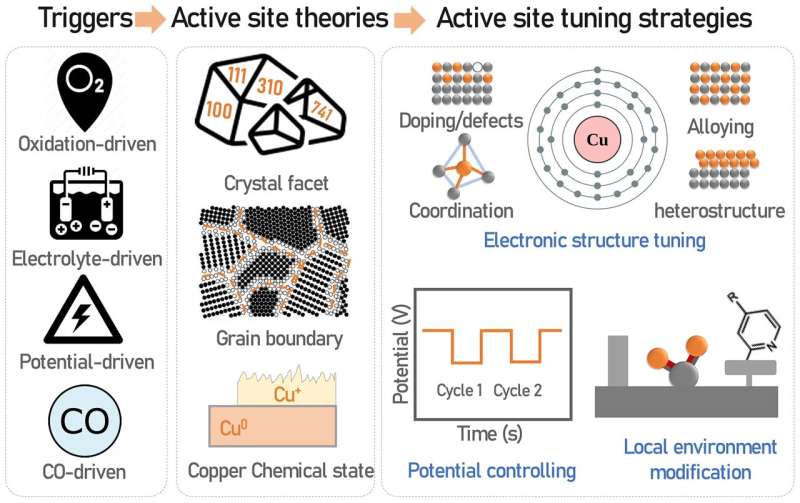This article has been reviewed according to Science X's editorial process and policies. Editors have highlighted the following attributes while ensuring the content's credibility:
fact-checked
trusted source
proofread
The dynamic evolution of copper-based catalysts for electrocatalytic carbon dioxide reduction

A review article, published in Science China Chemistry and led by Prof. Fan Dong and associate research fellow Bangwei Deng (Yangtze Delta Region Institute (Huzhou), University of Electronic Science and Technology of China), was written to inspire more investigations and studies on the intrinsic active sites during the dynamic evolution of catalysts that could promote the optimization of the catalyst system to further improve the performance of CO2RR.
To date, copper-based catalysts are one of the most prominent catalysts that can electrochemically reduce CO2 towards high value fuels or chemicals, such as ethylene, ethanol, acetic acid.
However, the chemically active feature of Cu-based catalysts hinders the understanding of the intrinsic catalytic active sites during the initial and the operative processes of CO2RR. The identification and engineering of active sites during the dynamic evolution of catalysts are thereby vital to further improve the activity, selectivity, and durability of Cu-based catalysts for high-performance CO2RR.
In this regard, four triggers for the dynamic evolution of catalysts were introduced in detail. Afterward, three typical active-site theories during the dynamic reconstruction of catalysts were discussed. In addition, the strategies in catalyst design were summarized according to the latest reports of Cu-based catalysts for CO2RR, including the tuning of electronic structure, controlling of the external potential, and regulation of local catalytic environment.
"The dynamic reconstruction of catalysts has now been well accepted by the research community, especially for Cu-based catalysts. Even though great advances have been achieved in the research of high performance CO2RR, however, the activity, selectivity, and durability for the industrial application of CO2RR on Cu-based catalysts are still unsatisfactory, particularly in the production of C2+ products. The detailed mechanisms on the intrinsic active site behind these dynamic properties, which are very important for the advanced catalyst design, are still ambiguous and more investigations are needed in future studies," Dong says.
Some perspectives are also given here to guide future studies: 1) The triggers of the dynamic evolution of Cu-based catalysts should be carefully investigated, since several factors (intermediates, electrolyte, applied potential) are present along during CO2RR; 2) More factors such as such as the electrolytic cell type, mass/electron transfer, local electric field, pH variations, solution resistance, hydrophilic/hydrophobic feature of reaction interface, and supporting effects should be considered during the catalyst design; 3) High-throughput testing and machine learning are efficient techniques to further establish the structure–property relationship in more complicated conditions.
More information: Bangwei Deng et al, Active site identification and engineering during the dynamic evolution of copper-based catalysts for electrocatalytic CO2 reduction, Science China Chemistry (2022). DOI: 10.1007/s11426-022-1412-6
Provided by Science China Press





















